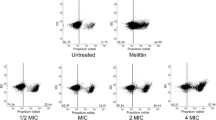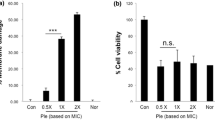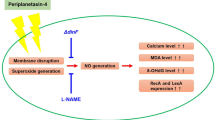Abstract
Arenicin-1, a 21-mer antimicrobial peptide exerts significant broad-spectrum antimicrobial activity with membrane-active mechanisms. However, owing to multiple mechanisms of cell death, the antibacterial mechanism of arenicin-1 requires detailed analysis. In the present study, arenicin-1-treated bacteria underwent an apoptosis-like response, which was mechanistically and morphologically similar to eukaryotic apoptosis. Changes in the physiological status of arenicin-1-treated bacterial cells involved accumulation of reactive oxygen species, imbalance of intracellular calcium gradients, disruption of membrane potential, bacterial caspase-like protein activation, and DNA damage. In arenicin-1-induced apoptosis-like death, autocleavage of LexA was observed because of the activation of the caspase-like activity of RecA. Additionally, typical reactive oxygen species such as superoxide, hydrogen peroxide, and hydroxyl radicals, were scavenged in arenicin-1-treated cells to assess the role of specific reactive oxygen species. Scavenging of hydrogen peroxide interfered with the activity of arenicin-1 in Escherichia coli, whereas the superoxide and hydroxyl radicals level did not affect arenicin-1-induced apoptosis-like death activity. Furthermore, inhibition of Fenton reaction attenuated apoptosis-like response. In conclusion, arenicin-1-induced apoptosis like death requires SOS response proteins and is mediated by hydrogen peroxide and Fenton reaction in E. coli. Arenicin-1 may be a representative antimicrobial peptide with potent apoptotic response against E. coli.





Similar content being viewed by others
Abbreviations
- PCD:
-
Programmed cell death
- TLD:
-
Thymine-less death
- ALD:
-
Apoptotic-like death
- AMP:
-
Antimicrobial peptides
- PBS:
-
Phosphate-buffered saline
- GSH:
-
Reduced glutathione
- DiBAC4(3):
-
Bis-(1,3-dibutylbarbituric acid) trimethine oxonol
- H2DCFDA:
-
2′,7′-Dichlorodihydrofluorescein diacetate
References
Adikesavan AK, Katsonis P, Marciano DC, Lua R, Herman C, Lichtarge O (2011) Separation of recombination and SOS response in Escherichia coli RecA suggests LexA interaction sites. PLoS Genet 7(9):e1002244. https://doi.org/10.1371/journal.pgen.1002244
Baym M, Stone LK, Kishony R (2016) Multidrug evolutionary strategies to reverse antibiotic resistance. Science 351(6268):aad3292. https://doi.org/10.1126/science.aad3292
Bidle KD (2016) Programmed cell death in unicellular phytoplankton. Curr Biol 26(13):R594–R607. https://doi.org/10.1016/j.cub.2016.05.056
Cansizoglu MF, Toprak E (2017) Fighting against evolution of antibiotic resistance by utilizing evolvable antimicrobial drugs. Curr Genet 63(6):973–976. https://doi.org/10.1007/s00294-017-0703-x
Cho J, Lee DG (2011a) The characteristic region of arenicin-1 involved with a bacterial membrane targeting mechanism. Biochem Biophys Res Commun 405(3):422–427. https://doi.org/10.1016/j.bbrc.2011.01.046
Cho J, Lee DG (2011b) The antimicrobial peptide arenicin-1 promotes generation of reactive oxygen species and induction of apoptosis. Biochim Biophys Acta 1810(12):1246–1251. https://doi.org/10.1016/j.bbagen.2011.08.011
Choi H, Lee DG (2012) Synergistic effect of antimicrobial peptide arenicin-1 in combination with antibiotics against pathogenic bacteria. Res Microbiol 163(6–7):479–486. https://doi.org/10.1016/j.resmic.2012.06.001
Choi H, Hwang JS, Lee DG (2016) Coprisin exerts antibacterial effects by inducing apoptosis-like death in Escherichia coli. IUBMB Life 68(1):72–78. https://doi.org/10.1002/iub.1463
Cochrane SA, Findlay B, Bakhtiary A, Acedo JZ, Rodriguez-Lopez EM, Mercier P, Vederas JC (2016) Antimicrobial lipopeptide tridecaptin A1 selectively binds to Gram-negative lipid II. Proc Natl Acad Sci USA 113(41):11561–11566. https://doi.org/10.1073/pnas.1608623113
Cox MM (2007) Regulation of bacterial RecA protein function. Crit Rev Biochem Mol Biol 42(1):41–63. https://doi.org/10.1080/10409230701260258
Dewachter L, Herpels P, Verstraeten N, Fauvart M, Michiels J (2016) Reactive oxygen species do not contribute to ObgE*-mediated programmed cell death. Sci Rep 6:33723. https://doi.org/10.1038/srep33723
Dominguez DC (2004) Calcium signalling in bacteria. Mol Microbiol 54(2):291–297. https://doi.org/10.1111/j.1365-2958.2004.04276.x
Dudas A, Markova E, Vlasakova D, Kolman A, Bartosova Z, Brozmanova J, Chovanec M (2003) The Escherichia coli RecA protein complements recombination defective phenotype of the Saccharomyces cerevisiae rad52 mutant cells. Yeast 20(5):389–396. https://doi.org/10.1002/yea.971
Dwyer DJ, Camacho DM, Kohanski MA, Callura JM, Collins JJ (2012) Antibiotic-induced bacterial cell death exhibits physiological and biochemical hallmarks of apoptosis. Mol Cell 46(5):561–572. https://doi.org/10.1016/j.molcel.2012.04.027
Dwyer DJ, Belenky PA, Yang JH, MacDonald IC, Martell JD, Takahashi N, Chan CT, Lobritz MA, Braff D, Schwarz EG, Ye JD, Pati M, Vercruysse M, Ralifo PS, Allison KR, Khalil AS, Ting AY, Walker GC, Collins JJ (2014) Antibiotics induce redox-related physiological alterations as part of their lethality. Proc Natl Acad Sci USA 111(20):E2100–E2109. https://doi.org/10.1073/pnas.1401876111
Erental A, Kalderon Z, Saada A, Smith Y, Engelberg-Kulka H (2014) Apoptosis-like death, an extreme SOS response in Escherichia coli. MBio 5(4):e01426–e01414. https://doi.org/10.1128/mBio.01426-14
Evans MD, Dizdaroglu M, Cooke MS (2004) Oxidative DNA damage and disease: induction, repair and significance. Mutat Res 567(1):1–61. https://doi.org/10.1016/j.mrrev.2003.11.001
Ferullo DJ, Lovett ST (2008) The stringent response and cell cycle arrest in Escherichia coli. PLoS Genet 4(12):e1000300. https://doi.org/10.1371/journal.pgen.1000300
Gorlach A, Bertram K, Hudecova S, Krizanova O (2015) Calcium and ROS: a mutual interplay. Redox Biol 6:260–271. https://doi.org/10.1016/j.redox.2015.08.010
Green J, Paget MS (2004) Bacterial redox sensors. Nat Rev Microbiol 2(12):954–966. https://doi.org/10.1038/nrmicro1022
Hakansson AP, Roche-Hakansson H, Mossberg AK, Svanborg C (2011) Apoptosis-like death in bacteria induced by HAMLET, a human milk lipid-protein complex. PLoS One 6(3):e17717. https://doi.org/10.1371/journal.pone.0017717
Hernansanz-Agustin P, Izquierdo-Alvarez A, Sanchez-Gomez FJ, Ramos E, Villa-Pina T, Lamas S, Bogdanova A, Martinez-Ruiz A (2014) Acute hypoxia produces a superoxide burst in cells. Free Radic Biol Med 71:146–156. https://doi.org/10.1016/j.freeradbiomed.2014.03.011
Hwang IS, Lee J, Hwang JH, Kim KJ, Lee DG (2012) Silver nanoparticles induce apoptotic cell death in Candida albicans through the increase of hydroxyl radicals. FEBS J 279(7):1327–1338. https://doi.org/10.1111/j.1742-4658.2012.08527.x
Kaufmann WK, Paules RS (1996) DNA damage and cell cycle checkpoints. FASEB J 10(2):238–247
Khademian M, Imlay JA (2017) Escherichia coli cytochrome c peroxidase is a respiratory oxidase that enables the use of hydrogen peroxide as a terminal electron acceptor. Proc Natl Acad Sci USA 114(33):E6922–E6931. https://doi.org/10.1073/pnas.1701587114
Kumar S, Engelberg-Kulka H (2014) Quorum sensing peptides mediating interspecies bacterial cell death as a novel class of antimicrobial agents. Curr Opin Microbiol 21:22–27. https://doi.org/10.1016/j.mib.2014.09.001
Kumar A, Pandey AK, Singh SS, Shanker R, Dhawan A (2011) Engineered ZnO and TiO(2) nanoparticles induce oxidative stress and DNA damage leading to reduced viability of Escherichia coli. Free Radic Biol Med 51(10):1872–1881. https://doi.org/10.1016/j.freeradbiomed.2011.08.025
Lam SJ, O’Brien-Simpson NM, Pantarat N, Sulistio A, Wong EH, Chen YY, Lenzo JC, Holden JA, Blencowe A, Reynolds EC, Qiao GG (2016) Combating multidrug-resistant Gram-negative bacteria with structurally nanoengineered antimicrobial peptide polymers. Nat Microbiol 1(11):16162. https://doi.org/10.1038/nmicrobiol.2016.162
Lee W, Lee DG (2014) Magainin 2 induces bacterial cell death showing apoptotic properties. Curr Microbiol 69(6):794–801. https://doi.org/10.1007/s00284-014-0657-x
Lee J, Lee DG (2016) Concentration-dependent mechanism alteration of pleurocidin peptide in Escherichia coli. Curr Microbiol 72(2):159–164. https://doi.org/10.1007/s00284-015-0937-0
Lee P, Tan KS (2015) Effects of Epigallocatechin gallate against Enterococcus faecalis biofilm and virulence. Arch Oral Biol 60(3):393–399. https://doi.org/10.1016/j.archoralbio.2014.11.014
Li T, Jiang L, Chen H, Zhang X (2008) Characterization of excitability and voltage-gated ion channels of neural progenitor cells in rat hippocampus. J Mol Neurosci 35(3):289–295. https://doi.org/10.1007/s12031-008-9065-7
Matic I (2017) The major contribution of the DNA damage-triggered reactive oxygen species production to cell death: implications for antimicrobial and cancer therapy. Curr Genet. https://doi.org/10.1007/s00294-017-0787-3
Matsuzaki K (2009) Control of cell selectivity of antimicrobial peptides. Biochim Biophys Acta 1788(8):1687–1692. https://doi.org/10.1016/j.bbamem.2008.09.013
Mishra S, Imlay J (2012) Why do bacteria use so many enzymes to scavenge hydrogen peroxide? Arch Biochem Biophys 525(2):145–160. https://doi.org/10.1016/j.abb.2012.04.014
Nagamalleswari E, Rao S, Vasu K, Nagaraja V (2017) Restriction endonuclease triggered bacterial apoptosis as a mechanism for long time survival. Nucleic Acids Res 45(14):8423–8434. https://doi.org/10.1093/nar/gkx576
Nie X, Gu J, Lu J, Pan W, Yang Y (2009) Effects of norfloxacin and butylated hydroxyanisole on the freshwater microalga Scenedesmus obliquus. Ecotoxicology 18(6):677–684. https://doi.org/10.1007/s10646-009-0334-1
Nordberg J, Arner ES (2001) Reactive oxygen species, antioxidants, and the mammalian thioredoxin system. Free Radic Biol Med 31(11):1287–1312
Panteleev PV, Bolosov IA, Balandin SV, Ovchinnikova TV (2015) Design of antimicrobial peptide arenicin analogs with improved therapeutic indices. J Pept Sci 21(2):105–113. https://doi.org/10.1002/psc.2732
Panteleev PV, Myshkin MY, Shenkarev ZO, Ovchinnikova TV (2017) Dimerization of the antimicrobial peptide arenicin plays a key role in the cytotoxicity but not in the antibacterial activity. Biochem Biophys Res Commun 482(4):1320–1326. https://doi.org/10.1016/j.bbrc.2016.12.035
Park C, Cho J, Lee J, Lee DG (2011) Membranolytic antifungal activity of arenicin-1 requires the N-terminal tryptophan and the beta-turn arginine. Biotechnol Lett 33(1):185–189. https://doi.org/10.1007/s10529-010-0402-x
Rios Colombo NS, Chalon MC, Navarro SA, Bellomio A (2018) Pediocin-like bacteriocins: new perspectives on mechanism of action and immunity. Curr Genet 64(2):345–351. https://doi.org/10.1007/s00294-017-0757-9
Shah AA, Wang C, Yoon SH, Kim JY, Choi ES, Kim SW (2013) RecA-mediated SOS response provides a geraniol tolerance in Escherichia coli. J Biotechnol 167(4):357–364. https://doi.org/10.1016/j.jbiotec.2013.07.023
Sharma V, Sakai Y, Smythe KA, Yokobayashi Y (2013) Knockdown of recA gene expression by artificial small RNAs in Escherichia coli. Biochem Biophys Res Commun 430(1):256–259. https://doi.org/10.1016/j.bbrc.2012.10.141
Shenkarev ZO, Balandin SV, Trunov KI, Paramonov AS, Sukhanov SV, Barsukov LI, Arseniev AS, Ovchinnikova TV (2011) Molecular mechanism of action of beta-hairpin antimicrobial peptide arenicin: oligomeric structure in dodecylphosphocholine micelles and pore formation in planar lipid bilayers. Biochemistry 50(28):6255–6265. https://doi.org/10.1021/bi200746t
Shkilnyj P, Colon MP, Koudelka GB (2013) Bacteriophage 434 Hex protein prevents recA-mediated repressor autocleavage. Viruses 5(1):111–126. https://doi.org/10.3390/v5010111
Tanwar J, Das S, Fatima Z, Hameed S (2014) Multidrug resistance: an emerging crisis. Interdiscip Perspect Infect Dis 2014:541340. https://doi.org/10.1155/2014/541340
Troxell B, Zhang JJ, Bourret TJ, Zeng MY, Blum J, Gherardini F, Hassan HM, Yang XF (2014) Pyruvate protects pathogenic spirochetes from H2O2 killing. PLoS One 9(1):e84625. https://doi.org/10.1371/journal.pone.0084625
Xu W, Zhu X, Tan T, Li W, Shan A (2014) Design of embedded-hybrid antimicrobial peptides with enhanced cell selectivity and anti-biofilm activity. PLoS One 9(6):e98935. https://doi.org/10.1371/journal.pone.0098935
Zgur-Bertok D (2013) DNA damage repair and bacterial pathogens. PLoS Pathog 9(11):e1003711. https://doi.org/10.1371/journal.ppat.1003711
Zhao X, Drlica K (2014) Reactive oxygen species and the bacterial response to lethal stress. Curr Opin Microbiol 21:1–6. https://doi.org/10.1016/j.mib.2014.06.008
Acknowledgements
This work was supported by the National Research Foundation of Korea (NRF) Grant funded by the Korean government (MSIP) (No. 2017R1A2B4005811).
Author information
Authors and Affiliations
Corresponding author
Ethics declarations
Conflict of interest
The authors declare that they have no conflict of interests.
Additional information
Communicated by M. Kupiec.
Electronic supplementary material
Below is the link to the electronic supplementary material.
294_2018_855_MOESM1_ESM.tif
Fig. S1. Oxidative stress in ΔRecA and K996 cells treated with arenicin-1. ΔRecA cells were treated with arenicin-1 (12.5 µM) or norfloxacin (2.3 µM). K996 cells were treated with arenicin-1 (12.5 µM) or norfloxacin (2.3 µM). (A) ROS production was detected via H2DCFDA staining (B) Decrease in GSH levels indicate oxidative damage. (C) Increase in MDA levels indicate lipid peroxidation. The data represents the average, standard deviation, and p values from three independent experiments (*p < 0.1; **p < 0.05; ***p < 0.01 vs the untreated; Student’s t test) (TIF 10063 KB)
294_2018_855_MOESM2_ESM.tif
Fig. S2. Features of apoptotic-like death in ΔRecA and K996 cells induced by arenicin-1. Analysis of membrane depolarization in ΔRecA and K996 cells in the presence/absence of arenicin-1 and ROS scavenger. Flow cytometric analysis of membrane depolarization using DiBAC4(3) (TIF 12006 KB)
294_2018_855_MOESM3_ESM.tif
Fig. S3 Features of apoptotic-like death in ΔRecA and K996 cells induced by arenicin-1. Analysis of cell filamentation in ΔRecA and K996 cells treated with/without arenicin-1 and ROS scavenger. Induction-mediated cell size changes. An increase in FS and SS indicated cell filamentation (TIF 13952 KB)
Rights and permissions
About this article
Cite this article
Lee, H., Lee, D.G. Arenicin-1-induced apoptosis-like response requires RecA activation and hydrogen peroxide against Escherichia coli. Curr Genet 65, 167–177 (2019). https://doi.org/10.1007/s00294-018-0855-3
Received:
Revised:
Accepted:
Published:
Issue Date:
DOI: https://doi.org/10.1007/s00294-018-0855-3




